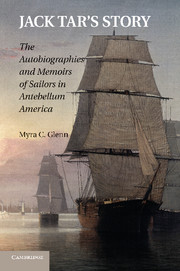Book contents
- Frontmatter
- Contents
- Acknowledgments
- List of Abbreviations
- Introduction: Why Study Antebellum Sailor Narratives
- 1 Stories of Escape, Freedom, and Captivity: Seamen Authors Recall Their Early Years
- 2 Manhood, Nationalism, and Sailor Narratives of British Captivity and the War of 1812
- 3 Exploring the Meaning of Revolution in the Americas: Sailor Narratives of the Haitian and South American Wars of Independence
- 4 Defending One's Rights as a Man and an American Citizen: Sailor Narratives as Exposés of Flogging
- 5 Straddling Conflicting Notions of Masculinity: Sailor Narratives as Stories of Roistering and Religious Conversion
- Afterword
- Appendix
- Index
1 - Stories of Escape, Freedom, and Captivity: Seamen Authors Recall Their Early Years
Published online by Cambridge University Press: 05 October 2010
- Frontmatter
- Contents
- Acknowledgments
- List of Abbreviations
- Introduction: Why Study Antebellum Sailor Narratives
- 1 Stories of Escape, Freedom, and Captivity: Seamen Authors Recall Their Early Years
- 2 Manhood, Nationalism, and Sailor Narratives of British Captivity and the War of 1812
- 3 Exploring the Meaning of Revolution in the Americas: Sailor Narratives of the Haitian and South American Wars of Independence
- 4 Defending One's Rights as a Man and an American Citizen: Sailor Narratives as Exposés of Flogging
- 5 Straddling Conflicting Notions of Masculinity: Sailor Narratives as Stories of Roistering and Religious Conversion
- Afterword
- Appendix
- Index
Summary
In 1849 Herman Melville published Redburn, one of his most popular novels. It offered a revealing glimpse into why many antebellum youths went to sea and how it transformed them. Redburn told the story of a provincial, naïve boy who shipped on board a packet bound for Liverpool. As his first name suggested, Wellingborough Redburn was well born, “a gentleman's son.” Yet the death of his father caused his genteel family to slip into poverty. Like so many actual youths in antebellum America, Redburn shipped out to sea to escape a difficult life on land. The world, he said, was “bitter cold as December, and bleak as its blasts …” Although only a boy Redburn described himself as already “a misanthrope … with the warm soul of me flogged out by adversity.”
Redburn was running away from much more than hard times and despair when he became a sailor. His description of the parting scene with his mother and three sisters suggested the eagerness with which he fled a feminized domesticity: “So I broke loose from their arms, and not daring to look behind, ran away as fast as I could …” Redburn's older brother, so ill that he could barely walk with him to the dock, was a cautionary example of what happened to males who did not leave home and strike out on their own.
- Type
- Chapter
- Information
- Jack Tar's StoryThe Autobiographies and Memoirs of Sailors in Antebellum America, pp. 24 - 49Publisher: Cambridge University PressPrint publication year: 2010

